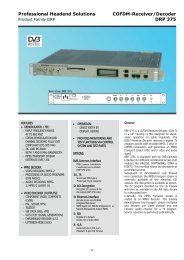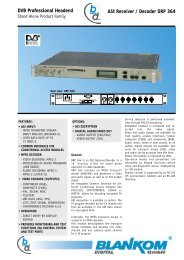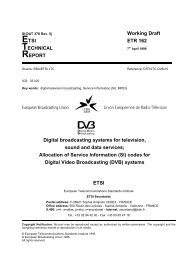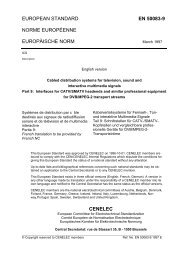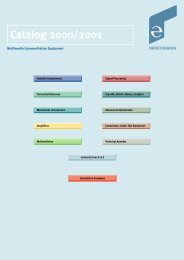Digital Video Broadcasting (DVB); User guidelines for Digital ...
Digital Video Broadcasting (DVB); User guidelines for Digital ...
Digital Video Broadcasting (DVB); User guidelines for Digital ...
Create successful ePaper yourself
Turn your PDF publications into a flip-book with our unique Google optimized e-Paper software.
video/audio/data bit stream to the physical channel, by adopting powerful channel coding and<br />
modulation techniques. The specified system offers many transmission modes (inner coding and<br />
modulations), giving different trade-offs between power and spectrum efficiency. QPSK modulation<br />
has been adopted, and optionally 8PSK and 16QAM modulations, and the concatenation of<br />
convolutional and Reed Solomon codes. The QPSK mode is compliant with the <strong>DVB</strong>-S system<br />
defined in [5], while <strong>for</strong> 8PSK and 16QAM, "pragmatic" trellis coding [25] has been applied,<br />
optimising the error protection of the same convolutional code. The QPSK and 8PSK modes, thanks<br />
to their quasi-constant envelope, are appropriate <strong>for</strong> operation with close to saturated satellite power<br />
amplifiers, in single carrier per transponder configuration. 16QAM (as well as QPSK and 8PSK) is<br />
appropriate <strong>for</strong> operation in quasi-linear satellite channels, in multi-carrier Frequency Division<br />
Multiplex (FDM) type applications, with high spectrum efficiency.<br />
For DSNG applications the usual method of accessing the transponders is Frequency Division<br />
Multiplexing (FDM), where part of the transponder bandwidth (frequency slot) is allocated to each<br />
signal. In order to reduce the effect of intermodulation noise introduced on adjacent carriers<br />
occupying the same transponder, the TWTA must be operated significantly below the saturation<br />
point. The linearity requirements are raised also by the fact that the aggregated FDM signal is no<br />
longer characterised by a constant envelope, even if each individual signal has quasi-constant<br />
envelope (e.g. QPSK or 8PSK). The higher is the spectrum efficiency of the modulation/coding<br />
scheme, the more stringent are the linearity requirements, because of the reduction of the system<br />
ruggedness against interferences.<br />
In relation with 8PSK and 16QAM, the <strong>DVB</strong>-DSNG specification [1] gives some warnings which are<br />
here reproduced:<br />
• they require higher transmitted EIRPs and/or receiving antenna diameters, because of their<br />
intrinsic sensitivity to noise and interferences;<br />
• they are more sensitive to linear and non-linear distortions; in particular 16QAM cannot be used<br />
on transponders driven near saturation;<br />
• they are more sensitive to phase noise, especially at low symbol rates; there<strong>for</strong>e high quality<br />
frequency converters should be used;<br />
• the System modulation/coding schemes are not rotationally-invariant, so that "cycle-slips" and<br />
"phase snaps" in the chain can produce service interruptions; there<strong>for</strong>e frequency conversions<br />
and demodulation carrier recovery systems should be designed to avoid cycle-slips and phase<br />
snaps.<br />
MUX<br />
Adaptation<br />
&<br />
Energy<br />
Dispersal<br />
MPEG-2 Source Coding and<br />
Multiplexing<br />
RS(204,188)<br />
Outer<br />
Coder<br />
Interleaver<br />
(I=12)<br />
Convolutional<br />
type<br />
Inner<br />
Coder<br />
Satellite Channel Adapter<br />
QPSK<br />
8PSK (optional)<br />
16QAM (optional)<br />
Bit<br />
Mapping<br />
Into<br />
Constellation<br />
Baseband<br />
Shaping<br />
According to EN 300421 According to EN 300421 <strong>for</strong> QPSK<br />
(*) = 0.25 <strong>for</strong> 8PSK and 16QAM (additional and optional)<br />
α<br />
Figure A. Functional block diagram of the System<br />
α=0.35<br />
(*)<br />
10<br />
to the RF<br />
Satellite<br />
Channel<br />
Quadrature<br />
Figure A gives a functional block diagram of the transmission system. The input stream, organised in<br />
188 bytes packets following the MPEG-2 transport multiplexer [3], is bit by bit randomised through a<br />
scrambling PRBS, in order to comply with the Radio Regulations interference requirements, which<br />
impose to have a regular spectrum shape of the transmitted signal, and to facilitate clock recovery in<br />
the receiver. Then the Reed-Solomon RS (204,188, t = 8) shortened code (derived from the original<br />
RS(255, 239, t = 8)), is applied to each randomised transport packet. Since, on the receiver side, the<br />
residual errors at the output of the Viterbi decoder are not statistically independent, but grouped in<br />
burst which may overload the RS code correction capability, the error distribution is randomised<br />
through a convolutional interleaver with depth I equal to 12 bytes applied to the error protected<br />
Modulator





